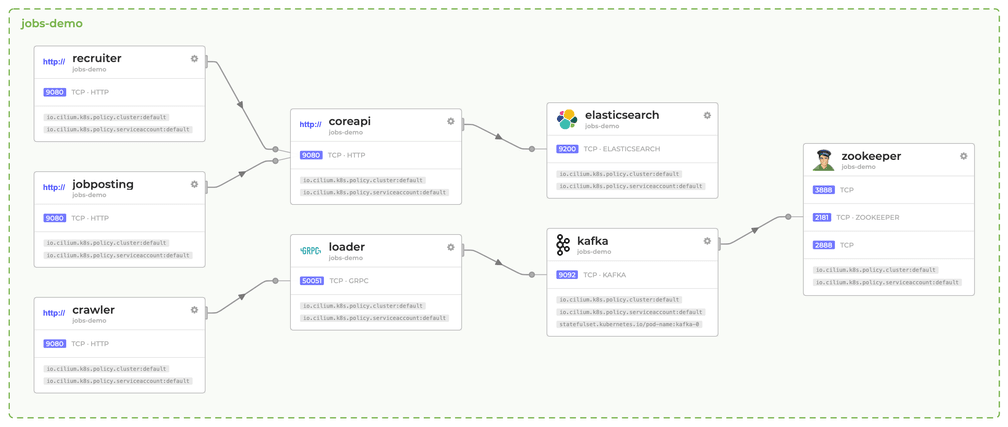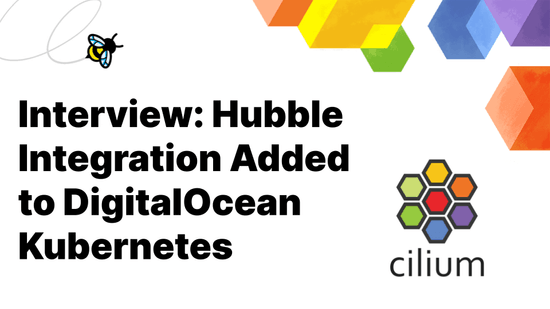Announcing Hubble - Network, Service & Security Observability for Kubernetes
Hubble is a fully distributed networking and security observability platform for cloud native workloads. Hubble is open source software and built on top of Cilium and eBPF to enable deep visibility into the communication and behavior of services as well as the networking infrastructure in a completely transparent manner.

Hubble can answer questions such as:
Service dependencies & communication map:
- What services are communicating with each other? How frequently? What does the service dependency graph look like?
- What HTTP calls are being made? What Kafka topics does a service consume from or produce to?
Operational monitoring & alerting:
- Is any network communication failing? Why is communication failing? Is it DNS? Is it an application or network problem? Is the communication broken on layer 4 (TCP) or layer 7 (HTTP)?
- Which services have experienced a DNS resolution problems in the last 5 minutes? Which services have experienced an interrupted TCP connection recently or have seen connections timing out? What is the rate of unanswered TCP SYN requests?
Application monitoring:
- What is the rate of 5xx or 4xx HTTP response codes for a particular service or across all clusters?
- What is the 95th and 99th percentile latency between HTTP requests and responses in my cluster? Which services are performing the worst? What is the latency between two services?
Security observability:
- Which services had connections blocked due to network policy? What services have been accessed from outside the cluster? Which services have resolved a particular DNS name?
Why Hubble?
The Linux kernel technology eBPF is enabling visibility into systems and applications at a granularity and efficiency that was not possible before. It does so in a completely transparent way, without requiring the application to change or for the application to hide information. By building on top of Cilium, Hubble can leverage eBPF for visibility. By relying on eBPF, all visibility is programmable and allows for a dynamic approach that minimizes overhead while providing deep and detailed visibility where required. Hubble has been created and specifically designed to make best use of these new eBPF powers.
Features
Service Dependency Graph
Troubleshooting microservices application connectivity is a challenging task. Simply looking at "kubectl get pods" does not indicate dependencies between each service or external APIs or databases.
Hubble enables zero-effort automatic discovery of the service dependency graph for Kubernetes Clusters at L3/L4 and even L7, allowing user-friendly visualization and filtering of those dataflows as a Service Map.
See Hubble Service Map Tutorial for more examples.

Metrics & Monitoring
The metrics and monitoring functionality provides an overview of the state of systems and allow to recognize patterns indicating failure and other scenarios that require action. The following is a short list of example metrics, for a more detailed list of examples, see the Metrics Documentation
Networking Behavior

Network Policy Observation

HTTP Request/Response Rate & Latency

DNS Request/Response Monitoring

Flow Visibility
Flow visibility provides visibility into flow information on the network and application protocol level. This enables visibility into individual TCP connections, DNS queries, HTTP requests, Kafka communication, and much more.
DNS Resolution
Identifying pods which have received DNS response indicating failure:
hubble observe --since=1m -t l7 -j \
| jq 'select(.l7.dns.rcode==3) | .destination.namespace + "/" + .destination.pod_name' \
| sort | uniq -c | sort -r
42 "starwars/jar-jar-binks-6f5847c97c-qmggv"Successful query & response:
starwars/x-wing-bd86d75c5-njv8k kube-system/coredns-5c98db65d4-twwdg DNS Query deathstar.starwars.svc.cluster.local. A
kube-system/coredns-5c98db65d4-twwdg starwars/x-wing-bd86d75c5-njv8k DNS Answer "10.110.126.213" TTL: 3 (Query deathstar.starwars.svc.cluster.local. A)Non-existent domain:
starwars/jar-jar-binks-789c4b695d-ltrzm kube-system/coredns-5c98db65d4-f4m8n DNS Query unknown-galaxy.svc.cluster.local. A
starwars/jar-jar-binks-789c4b695d-ltrzm kube-system/coredns-5c98db65d4-f4m8n DNS Query unknown-galaxy.svc.cluster.local. AAAA
kube-system/coredns-5c98db65d4-twwdg starwars/jar-jar-binks-789c4b695d-ltrzm DNS Answer RCode: Non-Existent Domain TTL: 4294967295 (Query unknown-galaxy.starwars.svc.cluster.local. A)
kube-system/coredns-5c98db65d4-twwdg starwars/jar-jar-binks-789c4b695d-ltrzm DNS Answer RCode: Non-Existent Domain TTL: 4294967295 (Query unknown-galaxy.starwars.svc.cluster.local. AAAA)HTTP Protocol
Successful request & response with latency information:
starwars/x-wing-bd86d75c5-njv8k:53410 starwars/deathstar-695d8f7ddc-lvj84:80 HTTP/1.1 GET http://deathstar/
starwars/deathstar-695d8f7ddc-lvj84:80 starwars/x-wing-bd86d75c5-njv8k:53410 HTTP/1.1 200 1ms (GET http://deathstar/)TCP/UDP Packets
Successful TCP connection:
starwars/x-wing-bd86d75c5-njv8k:53410 starwars/deathstar-695d8f7ddc-lvj84:80 TCP Flags: SYN
deathstar.starwars.svc.cluster.local:80 starwars/x-wing-bd86d75c5-njv8k:53410 TCP Flags: SYN, ACK
starwars/x-wing-bd86d75c5-njv8k:53410 starwars/deathstar-695d8f7ddc-lvj84:80 TCP Flags: ACK, FIN
deathstar.starwars.svc.cluster.local:80 starwars/x-wing-bd86d75c5-njv8k:53410 TCP Flags: ACK, FINConnection timeout:
starwars/r2d2-6694d57947-xwhtz:60948 deathstar.starwars.svc.cluster.local:8080 TCP Flags: SYN
starwars/r2d2-6694d57947-xwhtz:60948 deathstar.starwars.svc.cluster.local:8080 TCP Flags: SYN
starwars/r2d2-6694d57947-xwhtz:60948 deathstar.starwars.svc.cluster.local:8080 TCP Flags: SYNNetwork Policy Behavior
Denied connection attempt:
starwars/enterprise-5775b56c4b-thtwl:37800 starwars/deathstar-695d8f7ddc-lvj84:80(http) Policy denied (L3) TCP Flags: SYN
starwars/enterprise-5775b56c4b-thtwl:37800 starwars/deathstar-695d8f7ddc-lvj84:80(http) Policy denied (L3) TCP Flags: SYN
starwars/enterprise-5775b56c4b-thtwl:37800 starwars/deathstar-695d8f7ddc-lvj84:80(http) Policy denied (L3) TCP Flags: SYNGetting Started
See the links below to get started. While doing so, make sure to join the
#hubble channel on the Cilium Slack to share your experiences with others
exploring Hubble and to provide feedback to the Hubble development team.


